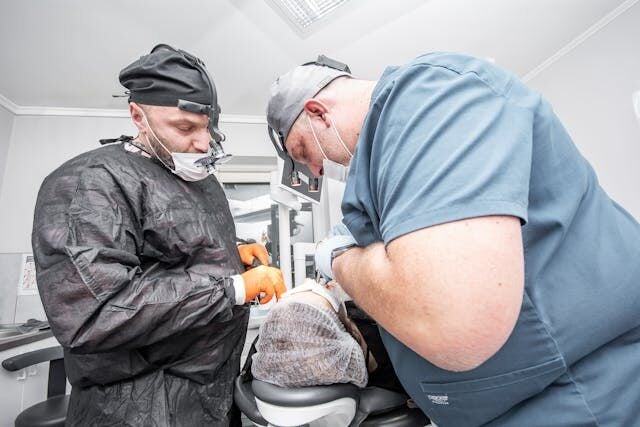
If you're considering ways to improve your facial contours, understanding the differences between surgical and non-surgical options is essential. Facelift surgery offers a more noticeable and long-lasting change compared to non-surgical alternatives. This is because the surgery involves lifting and tightening the underlying muscles and skin.
Non-surgical treatments like injectables and laser therapy can provide temporary improvements but typically do not last as long as a facelift. They might be right for you if you're looking for less invasive options with minimal recovery time. On the other hand, a procedure like a facelift in Toronto can deliver more significant improvements with effects that endure.
As you weigh the benefits and drawbacks of each approach, it's important to think about the results you desire and your readiness for recovery time. Would a temporary fix through non-surgical means be sufficient, or are you looking for the lasting impact that a facelift could provide?
Overview of Facelift Surgery
Facelift surgery offers a way to improve facial contours by lifting sagging skin and smoothing wrinkles. Through surgical techniques, a facelift can provide lasting changes to the appearance of the face and neck.
Defining Facelift Surgery
Facelift surgery, also known as rhytidectomy, is a procedure designed to combat the effects of aging on the face and neck. It focuses on tightening and lifting the skin to reduce sagging and wrinkles. The surgery addresses specific areas, such as the cheeks, jawline, and neck, which are prone to losing elasticity over time. By removing excess skin, it aims to restore a more youthful appearance.
The goal is not just to stretch the skin but to reposition underlying tissues for a natural look. This distinguishes a surgical facelift from more temporary, non-surgical options. It is typically sought by individuals looking for significant and long-term improvements in their facial structure.
Procedure and Techniques
During a facelift, surgeons use various techniques to address different areas of the face. Commonly, incisions are made near the hairline, stretching down around the ear. This approach allows access to deeper layers of tissue. In some cases, fat is repositioned or removed to improve contouring.
Muscle tightening is often a part of the procedure to achieve a firmer appearance. Techniques may vary based on desired outcomes and the specific areas targeted. Recovery typically involves some bruising and swelling, with full visible results taking a few weeks to emerge.
By understanding the steps involved, you get a clearer picture of what facelift surgery entails and how it differs from non-surgical options in its approach to improving facial contours. Experienced plastic surgeon Dr. Pasquale Tolomeo explains patients how the more information they have on the procedure, the more confident they feel about making decisions. This often helps them set realistic expectations before committing to surgery.
Comparative Analysis of Non-Surgical Alternatives
Non-surgical facelift options offer a way to refresh your look without undergoing surgery. These methods vary in approach, effectiveness, and longevity of results.
Types of Non-Surgical Treatments
There are several non-surgical treatments available. Dermal fillers add volume to the face, smoothing out wrinkles and lines. Another popular choice is radiofrequency treatments, which use energy to heat deeper layers of the skin. This helps stimulate collagen, improving skin tightness. There are also fat injections that can increase volume and create a youthful look. Other methods include laser treatments and chemical peels, which aim to improve skin tone and texture by removing the outer skin layers. Each option has different uses and benefits based on your skin needs.
Efficacy and Limitations
Non-surgical methods can achieve different degrees of success. Treatments like dermal fillers and radiofrequency are effective for adding volume and tightening the skin. However, these options usually offer temporary results and may require repeat sessions for maintenance. It's important to note that these treatments may not address issues like significant sagging. Risks can include mild swelling, redness, or temporary discomfort. Thus, while non-surgical facelifts improve certain aspects, they might not provide dramatic changes. The choice of treatment should be aligned with your specific goals and needs.
Facelift Versus Non-Surgical Results
When comparing surgical and non-surgical options, the main differences lie in the results and recovery time. A surgical facelift can significantly reshape facial contours and create long-lasting results. Non-surgical methods generally have less recovery time but may offer less drastic changes.

For example, radiofrequency can tighten skin, but it won't lift sagging like a surgical facelift. Fillers can address wrinkles, but their effects fade over time. It's essential to weigh the benefits and limitations of each option to choose the best treatment for your facial rejuvenation needs.
Deciding between facelift surgery and non-surgical alternatives for improving facial contours depends on your personal goals and preferences. Surgical facelifts offer long-lasting results by tightening facial skin and muscles, providing a more youthful appearance. Non-surgical options like fillers and Botox offer a temporary fix and require fewer recovery days.
It's important to weigh the benefits and limitations of each method. Surgical facelifts require downtime for healing but provide more significant changes. On the other hand, non-surgical techniques offer convenience and less risk.
Discuss with your healthcare provider what suits you best. Whether you seek dramatic changes or subtle improvements, there are options available for rejuvenating your appearance.




(0) comments
We welcome your comments
Log In
Post a comment as Guest
Keep it Clean. Please avoid obscene, vulgar, lewd, racist or sexually-oriented language.
PLEASE TURN OFF YOUR CAPS LOCK.
Don't Threaten. Threats of harming another person will not be tolerated.
Be Truthful. Don't knowingly lie about anyone or anything.
Be Nice. No racism, sexism or any sort of -ism that is degrading to another person.
Be Proactive. Use the 'Report' link on each comment to let us know of abusive posts.
Share with Us. We'd love to hear eyewitness accounts, the history behind an article.